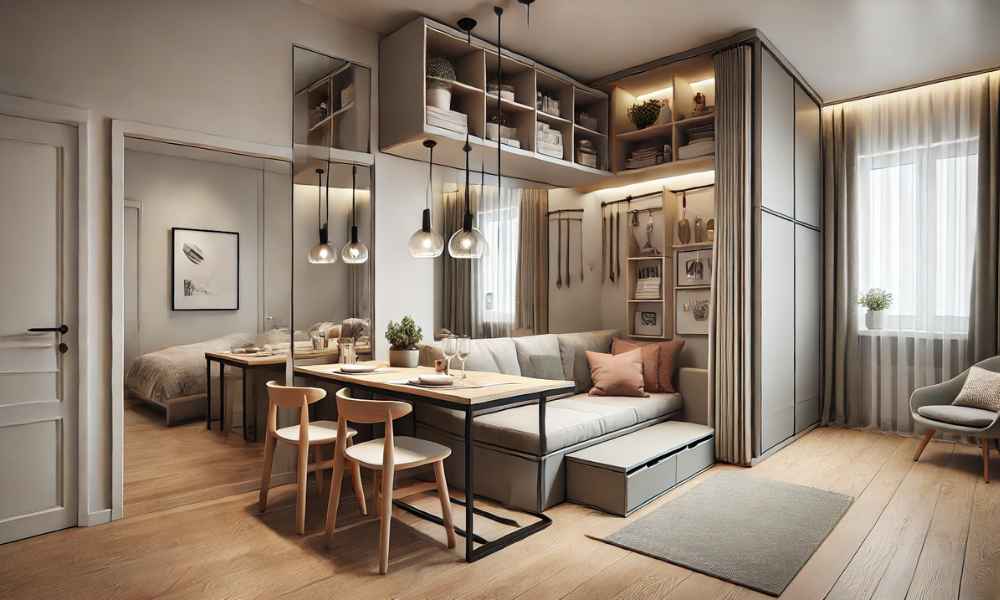Fit A Dining Table In A Small Living Room may seem like an impossible puzzle, but with the right approach, it can be a seamless and stylish addition to your space. Small-space living demands creativity, smart design choices, and multifunctional furniture solutions that maximize every inch. Whether you love hosting intimate dinners or need a functional spot for everyday meals, there are plenty of strategies to integrate a dine area without making your living room feel cramped. This guide explores space-efficient techniques, furniture choices, and clever placement strategies to help you create a comfortable dining nook, even in the most compact living spaces.
Assessing Your Living Room Space
Before bringing in a dining table, a careful assessment of your available space is crucial. Start by measuring the area where you envision placing the table. Consider not only the floor space but also how much clearance is needed for seating and movement. Pay attention to the natural flow of the room. Do people frequently pass through the area? Is there a corner that could be repurposed? Identifying potential obstructions, such as doors, pathways, or bulky furniture, helps in making an informed decision about placement. Using painter’s tape to mark different layout options can give a visual representation of how much space the table and chairs will occupy.
Choosing the Right Dining Table for a Small Living Room
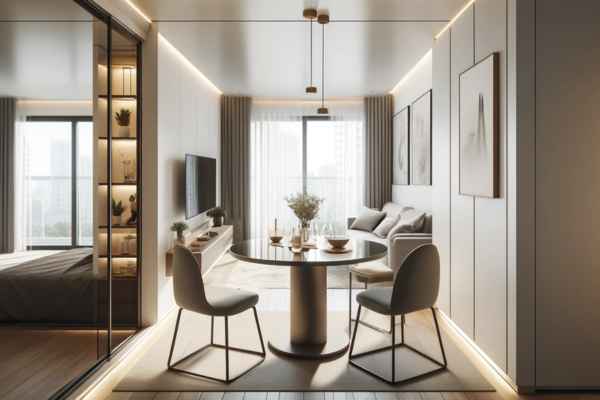
Selecting the appropriate dine table is key to ensuring it blends well into the living room without overwhelming it. Round tables are often a great choice for small spaces, as they lack sharp corners and provide flexible seating arrangements. If space is extremely tight, you can push a rectangular table against a wall when not in use, making it a smart alternative.
Consider extendable or drop-leaf tables, which give you extra surface area when needed but let you fold them down to save space. Glass-topped tables create the illusion of openness, making the room feel larger than it actually is. Slim pedestal bases instead of bulky legs can also make a noticeable difference in how much visual and physical space a table occupies.
Multifunctional Furniture: The Key to Space-Saving Dining
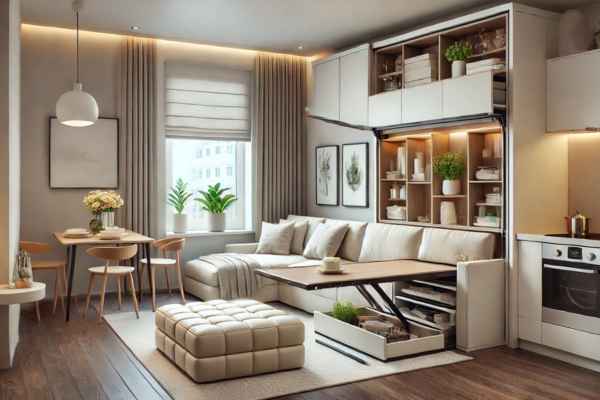
In small living rooms, every piece of furniture should serve more than one purpose. A dining table that doubles as a workspace or a storage unit can be a game-changer. Wall-mounted or fold-down tables offer maximum flexibility. You can fold these tables away when not in use, freeing up valuable space for other activities. Nesting tables provide a similar benefit, allowing for a quick expansion when guests arrive. Some ottomans or benches come with hidden storage, making them perfect for storing dine essentials like placemats, tableware, or napkins. A convertible coffee table that adjusts in height to function as a dining table can also be an innovative space-saving solution.
Creative Seating Solutions to Maximize Space
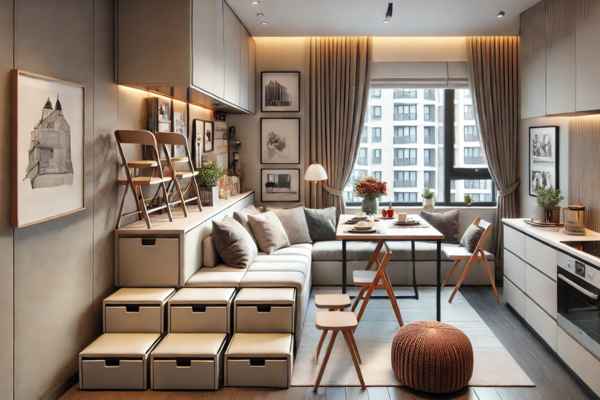
Seating can take up a significant amount of space, but there are creative solutions to ensure a comfortable dining experience without overcrowding your living room. Benches are a fantastic alternative to traditional chairs. You can push them underneath the table when not in use, saving floor space. Stackable chairs or foldable seating options allow for easy storage, ensuring your dining area remains clutter-free. Built-in seating, such as a corner banquette or a window seat with a dine table, maximizes space while adding a cozy, integrated look. Ottomans and poufs can serve as dual-purpose furniture, acting as seating when needed and blending seamlessly with the rest of the living room when not in use.
Integrating a Dining Area Without Overcrowding
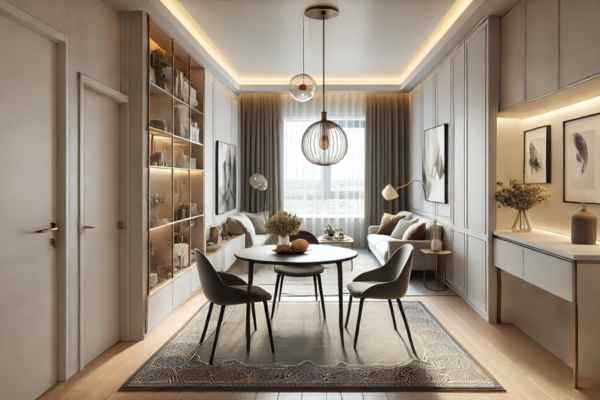
To avoid a cramped or cluttered look, it’s essential to visually separate the dine area from the rest of the living space while maintaining a cohesive design. Using an area rug under the table creates a subtle boundary, making the dining space feel intentional. Pendant lighting or a statement chandelier above the table can further define the dine zone without taking up any floor space. Light and airy furniture choices, such as slim-legged tables and open-back chairs, contribute to a sense of spaciousness. Keeping the dining table against a wall or in a corner when not in use can also help free up movement in the room.
Smart Placement Strategies for Your Dining Table
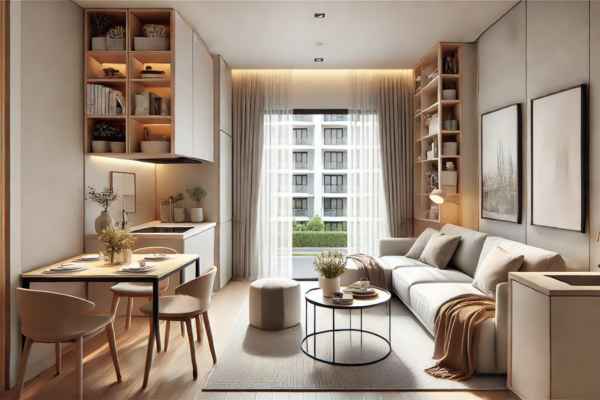
Strategic placement of your dining table can significantly impact the functionality and appearance of your living room. A few smart positioning ideas include:
- Against a Wall: A dine table positioned against a wall or tucked into a corner allows for more open space while still providing ample seating.
- Near a Window: Placing the table near a window makes the dining area feel bright and inviting, creating an illusion of more space.
- Multipurpose Centerpiece: If the living room layout allows, you can use a small dining table as a central focal point, letting it double as a coffee table or workspace when not in use.
- Behind the Sofa: In open-concept spaces, you can place a narrow dining table behind a sofa, creating a smooth transition between the living and dining areas.
Using Vertical Space to Your Advantage
Floor space is limited, vertical space becomes your best friend. Walls provide an excellent opportunity to incorporate storage and functionality without adding bulk to your living area. Consider installing floating shelves above the dining table to store dinnerware, decorative pieces, or even a small herb garden to add a fresh and lively touch. Wall-mounted folding tables are another great space-saving option—these can be tucked away when not in use, freeing up precious room for other activities.
Another creative idea is to use wall-mounted hooks or pegs to hang lightweight chairs or stools. This ensures extra seating is available when needed but doesn’t clutter the space when not in use. If your small living room also serves as an entertainment area, a mounted TV with shelving above and below can help declutter the floor, making the dining section feel less cramped.
Optical Illusions to Make Your Small Space Feel Bigger
Even the smallest living rooms can feel spacious with the right visual tricks. One of the most effective ways to create the illusion of more space is by using mirrors. Placing a large mirror on a wall near the dining area reflects light and depth, making the room appear larger than it actually is. A mirrored or glass dine table can also help reduce visual bulk, giving the illusion of openness.
Color choices play a significant role in perception. Light-colored furniture and walls, especially in shades of white, beige, or soft pastels, can make a room feel airy and expansive. If you prefer darker tones, consider using them for accents rather than dominant elements to avoid a closed-in feeling. Another trick is to use furniture with exposed legs—tables and chairs with slim, open designs create a sense of space by allowing light to pass through.
Blending Your Dining Table with Living Room Decor
A small living room should feel cohesive, with every piece of furniture complementing the overall aesthetic. Instead of treating your dining table as a separate entity, integrate it into your living room decor for a seamless look. Choose a table that matches the material and color scheme of your existing furniture. For example, if your living room has a modern minimalist vibe, opt for a sleek, neutral-toned table with clean lines. If you prefer a cozy, rustic atmosphere, a compact wooden dine table can blend naturally with warm textures and earthy colors.
Another effective way to tie the space together is through decor. Use matching cushions or seat covers that coordinate with your sofa, or add a small centerpiece to your dine table that echoes the style of your coffee table decor. A well-placed rug under the table can define the dining area while visually connecting it to the rest of the room. Keeping the overall look unified ensures that the dining setup feels like a natural part of your living space rather than an afterthought.
Dining Table Alternatives for Ultra-Tight Spaces
Your living room truly has no room for a full-sized dining table, don’t worry—there are plenty of alternative solutions that still allow for a comfortable dine experience. A convertible coffee table that can be adjusted in height and expanded when needed is a great option for those who prefer a more casual dining setup. Bar-height counters or narrow console tables placed against a wall can serve as compact dine spots while doubling as extra surface space for daily activities. Another ingenious solution is a pull-out or extendable table that can be tucked away when not in use. Some wall-mounted desks can even function as dining tables, offering flexibility without taking up unnecessary space. If you entertain guests occasionally but don’t need a permanent dining setup, consider nesting tables or a foldable dine set that can be stored away effortlessly.
DIY Space-Saving Dining Table Ideas
Store-bought space-saving furniture doesn’t fit your style or budget, consider a DIY approach to create a custom dining solution tailored to your living room’s unique dimensions. A fold-down wall-mounted table is one of the best DIY projects for small spaces—it can be fixed against the wall and folded away when not in use, making it perfect for those who need occasional dine space.
Another great idea is a repurposed console table that can double as a dining table. When not in use, it can serve as a decorative console behind the sofa or against a wall. When mealtime arrives, simply pull it out and pair it with collapsible chairs or stools. For even more versatility, a nesting table design allows for multiple table sizes to be stacked together, expanding when necessary while staying compact otherwise. If you enjoy woodworking, you might try building a bench-style dining setup with built-in storage underneath. This not only provides a space-efficient seating arrangement but also offers additional room to store dine essentials like placemats, napkins, and utensils. A DIY project like this adds both character and practicality to your living space.
Making Small Dining Work for Guests
Small spaces don’t have to mean sacrificing hospitality. Hosting guests in a small living room requires flexibility and smart planning to ensure a comfortable dining experience. Consider expandable tables that can be extended when needed and tucked away afterward. Drop-leaf tables are particularly useful, as they can be folded down when not in use but expanded to accommodate additional seating when guests arrive.
Seating is another challenge in compact areas, but stackable chairs, foldable stools, and benches can help provide extra spots without permanently taking up space. Storing these items in a closet or under other furniture when not in use keeps the room clutter-free. If a traditional dining setup isn’t feasible, opt for a casual dine arrangement, such as a coffee table picnic-style meal with floor cushions or a buffet-style setup where guests can serve themselves and eat on the sofa. Thoughtful touches like a well-placed rug to define the dine area, warm lighting, and stylish yet functional dishware can elevate the dining experience without requiring a large dedicated dining space.
Final Tips for a Functional and Stylish Dining Space
Creating a small dining space isn’t just about saving space—it’s about making the area feel intentional, comfortable, and visually appealing. One of the best ways to define your dine area is by using a rug underneath the table, helping to visually separate it from the rest of the living room. Opt for light, airy furniture to maintain an open feel. Avoid bulky, dark-colored tables and instead choose compact, minimalist designs with slim legs and glass or light-colored surfaces. Built-in seating along walls or windows can further maximize the space while adding an elegant, cohesive look.
Lighting plays a significant role in enhancing the ambiance of a small dining space. A pendant light or a sleek wall-mounted fixture can create a cozy, well-defined dine zone without taking up extra space. Similarly, incorporating mirrors or light-reflecting materials can make the space feel larger and more inviting. Lastly, keeping the area clutter-free is essential. Use smart storage solutions like wall-mounted shelves, built-in cabinets, or multipurpose furniture that can house dining essentials. The goal is to maintain a balance between functionality and aesthetics, ensuring the space remains both practical and stylish.
Conclusion
Even in the smallest living rooms, a well-planned dining area can be both practical and inviting. By incorporating DIY space-saving solutions, flexible seating arrangements, and a well-thought-out design, you can enjoy meals in comfort without sacrificing valuable space. Whether you choose a foldable table, a multifunctional dine solution, or a minimalist setup, the key is to prioritize versatility and efficiency. With these space-maximizing strategies, you can turn even the tiniest living room into a stylish, functional, and welcoming dining space.
